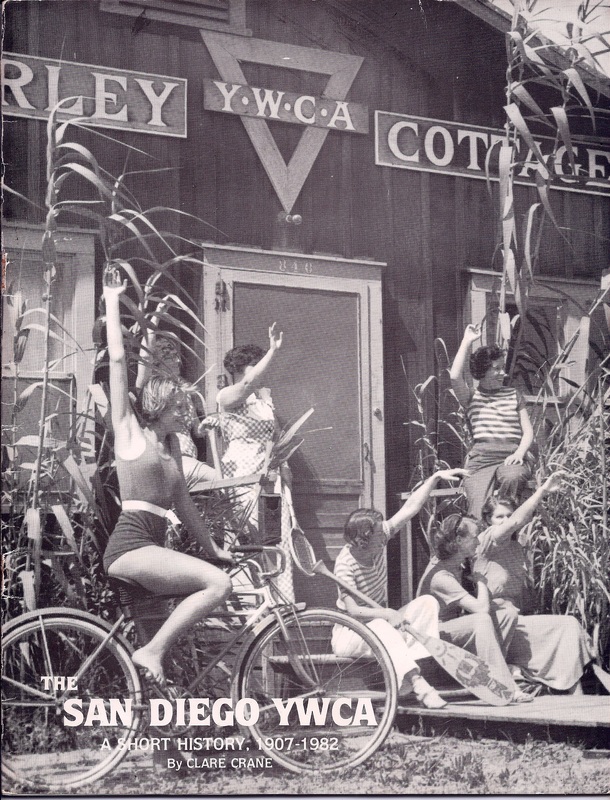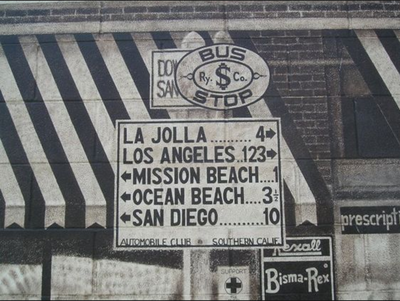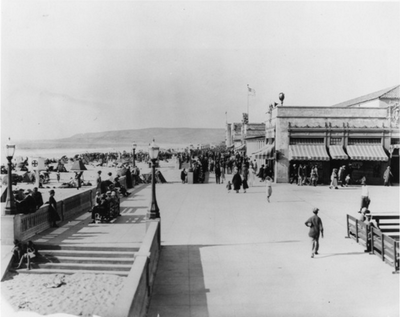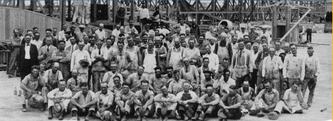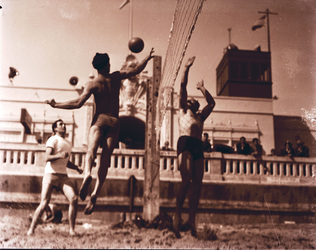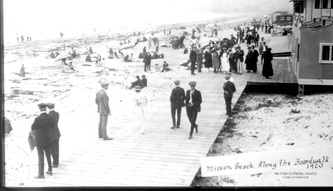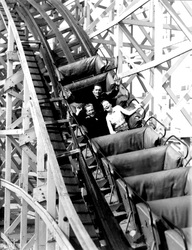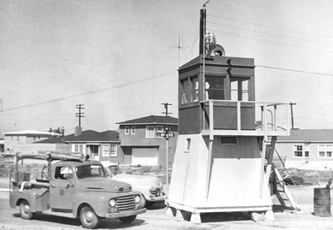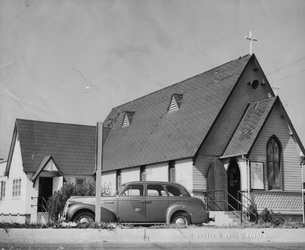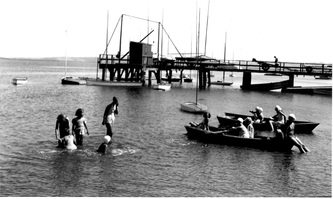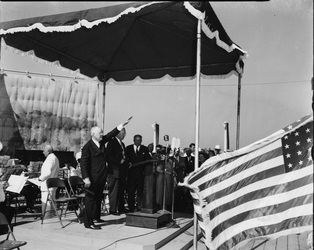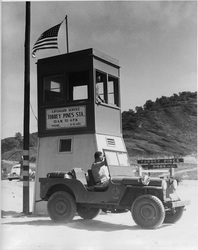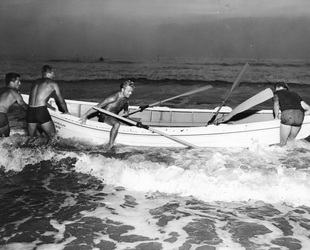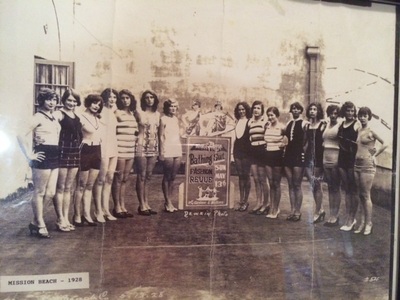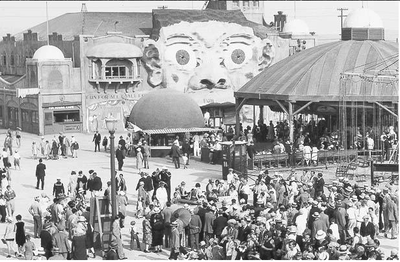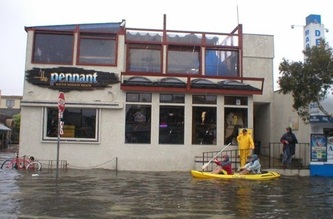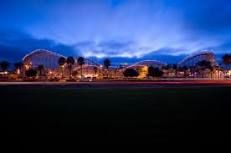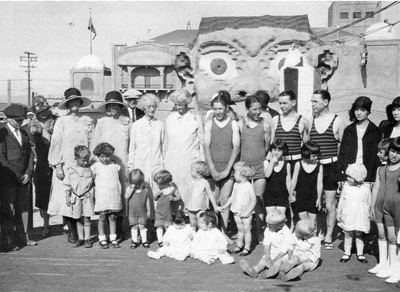
Mission Beach is a community built on a sandbar between the Pacific Ocean and Mission Bay.
It is part of the city of San Diego, California. In June, 1914, the official subdivision map was surveyed and on December 14, 1914, it was adopted by the Common Council of San Diego, becoming the first official map of Mission Beach.
Mission Beach spans nearly two miles of ocean front. It is bounded by the San Diego River estuary on the south, Mission Bay Park on the east, and the community of Pacific Beach on the north. A 'boardwalk' runs along the beaches on both the ocean and bay sides of the community. The main artery through Mission Beach is Mission Boulevard. The community is divided into South Mission, a peninsula, and Old Mission.
At the south end of the beach a jetty, with grass, parking and a walk, extends into the ocean.
The Father of Mission Beach, as he is known, was J.M. Asher, the developer who in 1916 spearheaded Mission Beach's Tent City. Pictures from the era show neat rows of striped, circus like tents interspersed with grassy, Hawaiian-style cabana huts. Mission Boulevard divided those at the water's edge from those set back from the water. The lots were for sale, and tent sites were available for rent, and while not the most luxurious accommodations, the tents allowed families and individuals to live right on the beach. Asher, in response to the influx in population and in order to cash in on the beachfront market even further, built a bathhouse on Redondo Court to accommodate the crowd. Eventually, more people began to stay year-round, having taken to the weather and beach lifestyle, making Tent City not only a viable resort but also a place to live. Tent City was dismantled in 1922 in response to stricter city codes regarding temporary housing and was soon replaced by permanent residences.
Spreckels had better luck than Asher did; some of what he built remains. In 1925, he constructed what was then called the Mission Beach Amusement Center, hoping to increase real estate interest in Mission Beach. The result was a games carnival, a ballroom, the Plunge swimming pool, and the Giant Dipper roller coaster, which is the second-oldest coaster ride in California. But Spreckels's structures were in for a bumpy ride; the amusement center, renamed Belmont Park in 1957, stalled out in the '60s and '70s, closing in December 1976. Threatened with demolition, the coaster had been added to the National Registry of Historic Places in 1978, affording it some legal protection. Eight years later it was designated a National Historic Landmark. In 1986, new Belmont Park developers, Paul Thoryk and Graham MacHutchin, came into the picture; their interest in the park was sold to Phase One Development, which opened the commercial center in 1988. All that remained of Spreckels's amusement park was the coaster and the Plunge. Thanks to the efforts of the Save the Coaster Committee, the Giant Dipper was up and running two years later. Its history has been recorded in a book, The Giant Dipper, San Diego, California: A Pictorial History, by Eric Young.
Like our Facebook page!
It is part of the city of San Diego, California. In June, 1914, the official subdivision map was surveyed and on December 14, 1914, it was adopted by the Common Council of San Diego, becoming the first official map of Mission Beach.
Mission Beach spans nearly two miles of ocean front. It is bounded by the San Diego River estuary on the south, Mission Bay Park on the east, and the community of Pacific Beach on the north. A 'boardwalk' runs along the beaches on both the ocean and bay sides of the community. The main artery through Mission Beach is Mission Boulevard. The community is divided into South Mission, a peninsula, and Old Mission.
At the south end of the beach a jetty, with grass, parking and a walk, extends into the ocean.
The Father of Mission Beach, as he is known, was J.M. Asher, the developer who in 1916 spearheaded Mission Beach's Tent City. Pictures from the era show neat rows of striped, circus like tents interspersed with grassy, Hawaiian-style cabana huts. Mission Boulevard divided those at the water's edge from those set back from the water. The lots were for sale, and tent sites were available for rent, and while not the most luxurious accommodations, the tents allowed families and individuals to live right on the beach. Asher, in response to the influx in population and in order to cash in on the beachfront market even further, built a bathhouse on Redondo Court to accommodate the crowd. Eventually, more people began to stay year-round, having taken to the weather and beach lifestyle, making Tent City not only a viable resort but also a place to live. Tent City was dismantled in 1922 in response to stricter city codes regarding temporary housing and was soon replaced by permanent residences.
Spreckels had better luck than Asher did; some of what he built remains. In 1925, he constructed what was then called the Mission Beach Amusement Center, hoping to increase real estate interest in Mission Beach. The result was a games carnival, a ballroom, the Plunge swimming pool, and the Giant Dipper roller coaster, which is the second-oldest coaster ride in California. But Spreckels's structures were in for a bumpy ride; the amusement center, renamed Belmont Park in 1957, stalled out in the '60s and '70s, closing in December 1976. Threatened with demolition, the coaster had been added to the National Registry of Historic Places in 1978, affording it some legal protection. Eight years later it was designated a National Historic Landmark. In 1986, new Belmont Park developers, Paul Thoryk and Graham MacHutchin, came into the picture; their interest in the park was sold to Phase One Development, which opened the commercial center in 1988. All that remained of Spreckels's amusement park was the coaster and the Plunge. Thanks to the efforts of the Save the Coaster Committee, the Giant Dipper was up and running two years later. Its history has been recorded in a book, The Giant Dipper, San Diego, California: A Pictorial History, by Eric Young.
Like our Facebook page!


